Cerro Torre - West face
1. Via dei Ragni (Ragni Route)
1.1 Directa Huarpe
600m 90˚ M4
Daniele Chiappa, Mario Conti, Casimiro Ferrari, and Pino Negri (Italy), 13/1/1974.
Description. This face has some of the most incredible ice formations to be found anywhere in the world. The approach involves climbing to the Col de la Esperanza, low angle snow (400m) to a short mixed section (100m, M3), followed by more easy snow (300m) and a last section with ice to 55º (150m). From the col itself more easy ice (to 70º) to the base of the Elmo (helmet) where you will find your first proper pitch and your first frost (mushroom ice) pitch. This pitch can be a half-hour to a two-hour affaire depending on conditions. An easy traverse from the top of the Elmo leads to three mixed pitches, the last one of which involves some M4/5. Two ice pitches lead to the headwall, which depending on conditions is AI5 or 5+. After the headwall, for the past 4 or 5 years there has been a naturally occurring tunnel that allows you to bypass the first mushroom on the ridge. If the tunnel is there this pitch will be AI3 and a matter of half an hour, if it is not it will be MI5 or 5+ and could require 2 or more hours. The second mushroom pitch has had a tunnel off and on, but even if it does not have it, it is far easier than the previous one. The third mushroom pitch is the crux of the route. It involves 50 meters of vertical frost, with the consistency of cotton candy. At times there might be a naturally occurring groove, at times it might be a vertical featureless face. The best alternative is to dig initially a half pipe and higher up a tunnel. Digging a tunnel is time consuming but ensures your safety, as you cannot fall off from inside it. It is advisable to use a fairly large stuff sack full of snow for a dead-man at the belay at its base. In this way you ensure protecting the second. The snow pickets don’t get much purchase on the frost, so it is best to protect the pitch by digging a tunnel. Parties in the last few years have taken between 4 to 5 hours to dig through that pitch, although you might be lucky to find better conditions and get through it much faster. If it has been climbed before that same season you might be able to climb it in as little as half an hour. For the sake of efficiency and speed many parties divide digging duty, with one guy climbing the first half of the pitch and a second guy taking over. Lowering is not an easy proposition, but if you equalize two pickets plus your icetools you should be able to lower safely.
History. Chiappa, Conti, Ferrari and Pino Negri made the first ascent of the peak via this route. They were part of a big “Ragni di Lecco” expedition that included Gigi Alippi, Ernesto Panzeri, Pierlorenzo Acquistapace, Sandro Liati (doctor), Giuseppe Lafranconi, Claudio Corti, Angelo Zoia and Mimmo Lanzetta (photographer). They reached the summit after nearly two months of attempts, on their very last day, as food run out. Part of team was forced to descend so that the little remaining food would be enough to give the four-man team a reasonable chance to attempt the summit.
Carlo Mauri and Walter Bonatti were the first to attempt this line. In early 1958 they managed to reach the base of a formation they called the Elmo (helmet), 120 meters above the col between Adela and Torre, 400 meters below the summit before the technical difficulties and lack of the appropriate equipment forced them to retreat. Folco Doro Altan and René Eggmann climbed with them to the col, which they christened col “della Speranza” (col of hope) because while descending they already envisioned returning to attempt the route the following year (it was called col “dell’Adela” until then). The expedition had been organized by Altán, an Italian residing in Argentina, and had a total of ten members including Vittorio Doro Altán, Horacio Solari, Héctor Forte, Eberhard Heinrich, Miguel Angel Garcia and José Losada. Their original intent was to attempt Cerro Torre from the east side, but the presence of an expedition from Trento led by Bruno Detassis, that included Cesare Maestri forced them to attempt the mountain via its unknown and difficult to reach west face. Not content with their valiant attempt on Cerro Torre, Bonatti, Mauri, Doro Altan and Eggmann went on to complete the first ascent of Cerro Mariano Moreno, climbing it in a 36 hour non-stop push. Two days after that, Bonatti and Mauri completed an impressive one-day traverse of the Adela massif, climbing three virgin summits, an impressive accomplishment even by today’s standards (see Cerro Adela). After the expedition Bonatti and Mauri returned to Italy in a hurry to participate in an expedition to Gasherbrum IV, of which they made the first ascent, showing clearly that they were the strongest alpinists at the time.
In 1970 Mauri returned as the leader of the “Città di Lecco” expedition, that amongst its eight members included Casimiro Ferrari and Pierlorenzo Acquistapace, who four years later would be part of the team that made the first ascent. Also part of the expediton were Gianni Stefanon, Roberto Chiappa, “Pomela” Lanfranconi, Piro Ravà, Gianfelice Rocca and Giuseppe Cima. Mauri’s team was confronted by continuous bad weather and were forced to retreat 250 meters below the summit, after having surpassed the Elmo, one of the three crux sections. It was after this attempt that Mauri wrote his now famous telegram saying that they had failed one more time to climb the impossible Cerro Torre: “La nostra vittoria è nel fatto che tutti torniamo sani e salvi dall’impossibile Torre” (Rassegna Alpina 15 p. 86).
The second ascent of the mountain and of this route was done just three years later, in January 1977, when Americans John Bragg, Dave Carman and Jay Wilson climbed it in pure alpine style. It should be noted that although the first ascent of this route was done with extensive use of fixed ropes all the repeats to this day have been done in pure alpine style. The fast American ascent of 1977 shows clearly the advance that North America had over Europe as far as ice climbing technique goes at the time. The flair and ease with which Bragg and partners climbed CT is indeed impressive, perhaps a sign of a flourishing time in alpine climbing in the US. Three years earlier, the year of the first ascent of the Ragni Route, Chris Jones and George Lowe had completed the first ascent of the 1500 meter tall north face of North Twin in perfect alpine style, a face and a route every bit as remote and much more difficult that the west face of Cerro Torre (only one repeat ascent to date).
Free ascent. In February of 1986, Michael Bearzi and Eric Winkelmann (USA) did the first free ascent of Cerro Torre via this route, climbing sections of AI6. They climbed in the best possible style that existed at the time, using leashes but not hanging from ice-tools or ice-screws in the middle of pitches. They took three days up and down.
Winter ascent. In July of 1999, Swiss Thomas Ulrich, Stephan Siegrist and David Fasel, with American Gregory Crouch reached the summit plateau, at the base of a an 6 meter tall summit mushroom. On their first attempt they fixed three ropes, two on the mixed pitches leading to the col della Speranza and one on the Elmo. Because of the cold they found extremely hard ice conditions on which just getting screws to turn was very hard work. On their final attempt they bivied at the col and a second time on top of a small mushroom after the headwall. Ulrich showed that his years spent behind the lens had not taken away any of his brilliance as a climber, as it was him who lead all three cruxes. In August of 2013 Siegrist returned to the route with Dani Arnold, Thomas Huber and Matías Villavicencio, climbing the route to the very summit.
Solo ascent. Walter Hungerbuhler (Switzerland) the 9/12/2008. Walter’s was the first solo ascent of the route, the first solo ascent of Cerro Torre without Maestri’s bolts and the 4th solo ascent of the peak. Walter approached via the Standhardt col, and belayed himself in two pitches, the headwall and the last mushroom pitch. The route was well “hacked”, having been climbed by ten people on that very same day, and by ten other people a few days earlier. Walter was the first solo climber to climb Cerro Torre without ever roping up with other climbers, on approach or descent.
In early 2013 Markus Pucher (AT) did the first free-solo ascent of the route in a mere 3:15 hours from the plateau 150m below the Col de la Esperanza, 5:40 hours round trip. The route had been climbed by close a hundred people earlier in the season. In late 2014 Pucher repeated the same feat, this time in a total white-out, with nobody around. A lenghty account of this impressive ascent here.
Wnter solo attempts: in August of 2014 Colin Haley climbed to right below the Elmo, retreating when he found brittle ice and lots of rime. In September of 2015, Markus Pucher clmbed the top of the Elmo, retreating due to the copious amount of rime. It remains to be seen if the climb wll ever be soloed in virgin condition. All solos to date are behind many parties, with all the ptches nicely cleaned up of rime and other.
Female ascents. The first female ascent of the route was done by Doerte Pietron (DE) in late 2008. During the 2012-13 season there were many other female ascents. In early 2015 Caroline North and Christina Huber (DE) did the first female team ascent of the route. The only other female team ascent of Cerro Torre was done by Monika Kambic (AR) and Tanja Grmovsek (SI) in 2005, via the Compressor Route, jumaring the crux pitch on a rope fixed by another party.
List of ascents.
- Chiappa, Conti, Ferrari, and Negri in 1974. First ascent of the peak.
- Bragg, Carman and Wilson in 1977. First alpine style ascent.
- Bearzi and Winkelmann in 1986. First free ascent.
- David Authemann, Patrick Pessi and Fred Valet (France) in 1994 to the summit plateau, at the base of the final mushroom.- Simon Elias and Josu Merino (Spain), in February 1997.
- Greg Crouch (USA), David Fasel, Stefan Siegrist and Thomas Ulrich (Switzerland) to the summit plateau, at the base of the final mushroom, which that year was merely 6 meters tall, in the winter of 1999.- Ramiro Calvo, Gabriel and Luciano Fiorenza, Max Odell, Walter Rossini (Argentina) and Bruno Sourzac (France), in December 2005. - Kelly Cordes and Colin Haley (USA), January 2007, first link up with Los Tiempos Perdidos in CT’s south face. - Jorge Ackermann, Tomas Aguilo, Carlos Cabezas, and Matias Villavicencio (Argentina) the 1/12/2008. - Rolando Garibotti (Arg.) and Doerte Pietron (Germany), the 1/12/2008. Sharing the last pitch with the party above. Pietron's was the first female ascent of the route and the 7th female ascent of the peak (all others via the Compressor Route). - Ole Lied and Trym Atle Saeland (Norway) climbing from the SE ridge by traversing above the south face, doing the first ascent of the Corkscrew route, the 2/12/2008. They had hope to do a bolt-free ascent, but a snow mushroom at the start of Salvaterra variation, just before the bolt traverse on the SE ridge forced them to use some of Maestri's Compressor route bolts before traversing west. The Corkscrew was originally conceived by an English-Argentine expedition in 1968 (Fonrouge, Haston, etc). - Mateo Bernasconi and Fabio Salini (Italy), the 2/12/2008.
- Julien Dusserre, Pierre Labbre, Baptiste Rostaing Puissant and Jerome Para (France), the 9/12/2008. - Walter Hungerbuhler (Switzerland), also the 9/12/08 (see earlier).
- Nico Benedetti, Flavio Renzacci, Fernando Irrazabal and Jimmy Heredia (Argentina), also the 9/12/08. - Bjørn-Eivind Årtun (Norway) and Cullen Kirk (USA), also the 9/12/08, but taking a mere 13 hours from Niponino camp to the summit via the Standhardt col. - Michi Lerjen (Switzerland) and Korra Pesce (Italy) in 11/11.
- Sergio Camacho (Spain) and Charly Galosi (Argentina) in 12/11 to the summit plateau, at the base of the final mushroom.- Lincoln Else (USA), Toni Ponholzer and Markus Pucher (Austria) in 1/12, accesing Circo de los Altares via helicopter, landing illegally inside the National Park, as part of a film production.- Bjørn-Eivind Årtun (Norway) and Chad Kellog (USA), 1/12.
- Max O'Dell, Juan Manuel and Agustin Raselli (Argentina) after traversing the Adela Range, climbing "mini Torre", a previously unclimbed summit west of Punta Luca, traversing below Cerro Grande, to climb Cerro Doblado, Cerro Nato, Cerro Adela Sur, Central and Norte, to descend to the Col de la Esperanza and get onto the Ragni route, in 1/2012. They approached from Laguna Toro, climbing part away Mini Torre before bivouacking. Next day they climbed to the col between Nato and Adela Sur. On day three they descended to the Col de la Esperanza and bivied at the base of the Elmo. Day four they climbed to the summit of Torre and back, to bivy again there before walking out via Circo de los Altares and Paso del Viento.
- Gabriel Fava, Javier Giuliani and Roberto "Indio" Treu (Argentina), 3/12.
- Jose Bonacalza and Diego Simari (Argentina), 3/12 (sharing the Elmo and last pitch with the party above).
2012-2013 Season.
The bolt removal along the Compressor Route lead to renewed interest in this climb. A combination of repeated ascents and considerable lack of rime due to much drier weather made the climb much easier and straight forward than previously thought leading to a ferocious slew of repeats. Over 140 people repeated the route between November 2012 and March 2013. Amongst them there were several female ascents as well as a few guided ascents, the first by mountain guide Michi Wärthl (DE), which was the first guided ascent of the route and the peak.
Various. To March of 2012, the list of non-Compressor route ascents of Cerro Torre, to the very summit, was 22 ascents. These includes 18 of the ascents listed above minus those that stopped shy of the summit (base of the summit mushroom), those that were not fully human powered (helicopter access), or those that used some of the Compressor Route bolts for progression (Corkscrew), plus Alessandro Beltrami, Ermanno Salvaterra and Rolando Garibotti’s November 2005 ascent of El Arca de los Vientos; Colin Haley and Rolando Garibotti’s January 2008 Torre Traverse finishing also via El Arca; Hayden Kennedy and Jason Kruk's 2012 ascent of the SE ridge; and David Lama and Peter Ortner's 2012 free ascent of the SE ridge.
Approach. There are two very different alternatives, via Paso Marconi to Circo de los Altares, or from the Torre valley over the Standhardt col. If you are part of a rich film crew you may take a helicopter and land illegally in Circo de los Altares. The Park will willingly look the other way...
Gear. Full ice kit (8 to 12 screws, etc), 4 medium size camalots (0.5 to 2) and 5 stoppers. A "mushroom kit" (iceaxe wings, 2 or more pickets, stuff sacks for deadmen) had been mandatory until 2011, but dry climate the last few seasons has greatly reduce the amount of rime on the route making such a kit unnessesary. Time will tell how "permanent" this lack of rime will be.
Descent. Via the same route, much much safer and faster than descending the SE ridge.
Bibliography.
First ascent: AAJ 1974 p. 201; La Montagne et Alpinisme 97 p. 302; Mountain Magazine 37 p. 10-11; Mountain Magazine 38 p. 26-29; Annales GHM 1974 p. 8-9 (good technical description); CAI-Rivista Mensile 1974/5 p. 163-172; Ferrari C. (1975) Cerro Torre - Parete Oest, Dal Oglio; Benini A. (1996) Ragni di Lecco - 50 anni sulle montagne dell mondo, Vivalda, Torino (p. 148-159); Fantin M. (1979) Le Ande, CAI, Milano (p.130-133).
1958 attempt and Gasherbrum: AAJ 1959 p. 317; CAI- Rivista Mensile 1959/1-2 p. 32-39; Mario Fantin (1972) Alpinisti Italiani nell Mondo, Commissione Centrale delle Pubblicazioni, Club Alpino Italiano 1972/2 p. 835-836; Lo Scarpone, 1958/1 p .1; Lo Scarpone, 1958/2 p. 1; Lo Scarpone, 1958/5 p. 1; Lo Scarpone, 1958/20 p. 1; Rho F. and Mauri F. (1997) Carlo Mauri - Il Viaggiatore dei Sogni, Ferrari Ed., Clusone (p. 48-57); Bonatti W. (1961) Le Mie Montagne, Zanichelli, Bologna (p. 191-214); Bonatti W. (1979) On the Heights, Diadem Books, London (p. 153-169); Bonatti W. Montagne de una vita, p. 137-152; Corriere degli Italiani, Bs As, Argentina 6/1/58 p. 7 (announcement); Corriere degli Italiani, Bs As, Argentina 3/3/58 p. 7 (results).
1970 Attempt: Mountain magazine 9 p. 6; Mountain magazine 11 p. 16-23; AAJ 1971 p. 430-431; Mario Fantin (1972) Alpinisti Italiani nell Mondo, Commissione Centrale delle Pubblicazioni, Club Alpino Italiano 1972/2 p. 853; Rassegna Alpina, Eurograph Bernardoni, Milano, Italia 15 p. 84-91; Rho F. and Mauri F. (1997) Carlo Mauri - Il Viaggiatore dei Sogni, Ferrari Ed., Clusone (p. 48-57).
Bragg: Rock and Ice magazine 3 p. 6-11; AAJ 1978 p. 581.
Bearzi: Rock and Ice magazine 15 p. 42-51; Mountain 119 p. 12; Mountain Review magazine 9 p. 30; AAJ 1987 p. 212.
Elias: AAJ 1997 p. 246; Pyrineaica 1997/2 p. 280-285 #187; Desnivel magazine 128 p. 32-39.
Winter Ascent: Gregory Crouch (2002) Enduring Patagonia, Random House, USA. |
Photos (click to enlarge)
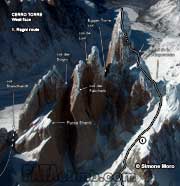
Cerro Torre west face 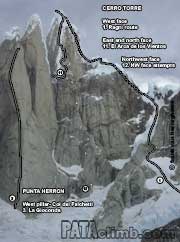
Cerro Torre northwest face 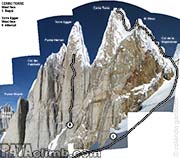
Cerro Torre northwest face 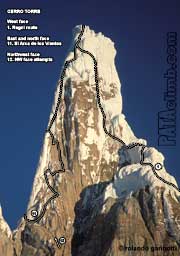
Cerro Torre northwest face 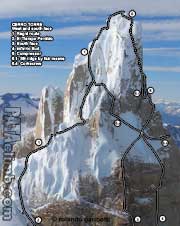
Cerro Torre southwest face 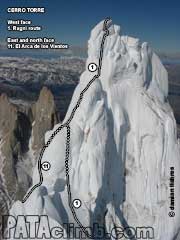
Cerro Torre west face |





